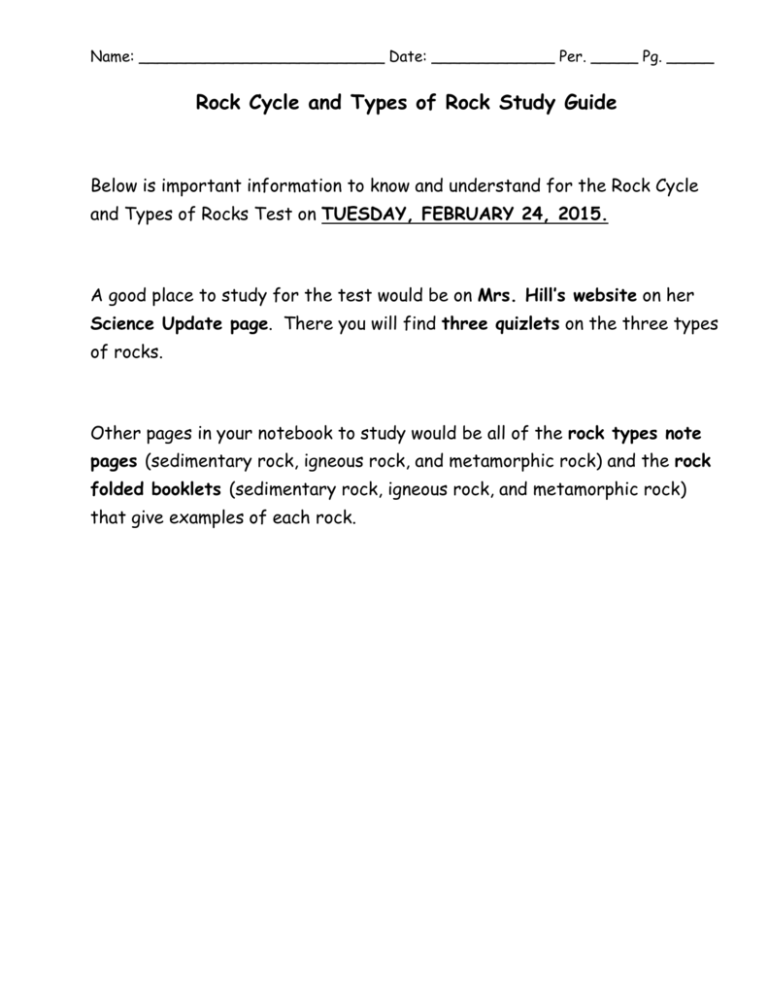Sedimentary rocks - Madison Public Schools
advertisement

Name: __________________________ Date: _____________ Per. _____ Pg. _____ Rock Cycle and Types of Rock Study Guide Below is important information to know and understand for the Rock Cycle and Types of Rocks Test on TUESDAY, FEBRUARY 24, 2015. A good place to study for the test would be on Mrs. Hill’s website on her Science Update page. There you will find three quizlets on the three types of rocks. Other pages in your notebook to study would be all of the rock types note pages (sedimentary rock, igneous rock, and metamorphic rock) and the rock folded booklets (sedimentary rock, igneous rock, and metamorphic rock) that give examples of each rock. Sedimentary Rocks Sedimentary Rocks: Sedimentary rocks are rocks that are made from pieces of broken rock and sediments. Clasts are fragments of weathered rock (sediments). Stratification is the process called in which sedimentary rocks are arranged in layers or strata. Types of Sedimentary Rocks: Clastic sedimentary rock forms when weathered layers of rock or mineral pieces are deposited, compacted, and cemented (glued) together. o Examples – conglomerate and sandstone Chemical sedimentary rock forms from solutions of dissolved minerals and water. o Examples – calcite and halite (rock salt) Organic limestone forms from the remains of once living things (fossilized plants and animals). o Examples – coal and coquina Igneous Rocks Igneous Rocks: Igneous rock forms when magma/lava (molten rock) cools and hardens. o Magma is molten rock under the Earth’s surface. o Lava is molten rock above the Earth’s surface. The texture of igneous rock is created by how the rock cools. o Fast – fine-grained and small or no crystals o Slow – coarse-grained and large crystals Mafic –igneous rock with more magnesium and iron. o The rock is darker in color and denser. Felsic –igneous rock with more silicon and aluminum. o The rock is lighter in color and less dense. Types of Igneous Rocks: Intrusive igneous rock is rock that solidifies under the Earth’s surface. Magma that cools slowly underground forms large crystals. o Examples – granite and gabbro Extrusive igneous rock is rock that solidifies at Earth’s surface. Lava that cools rapidly forms small crystals. o Examples – obsidian and pumice Metamorphic Rocks Metamorphic Rocks: Metamorphic rocks form from change in heat and pressure. Metamorphism is the process of heat and pressure changing the minerals in a rock into new minerals. Deformation is the process in which metamorphic rocks change shape. Index minerals can indicate the temperature and pressure, or depth, at which a rock was formed. How Metamorphic Rocks Change: Regional metamorphism – when a rock changes because of change in temperature and pressure over a large area from tectonic plates moving. Contact metamorphism – when a rock changes because it comes in contact with magma and changes the rocks in a small area. Types of Metamorphic Rocks: Foliated metamorphic rock has mineral grains arranged in lines or bands (stripes). o Examples – gneiss and slate Nonfoliated metamorphic rock is a smooth rock that has mineral grains NOT arranged in lines or bands (stripes). o Examples – marble and quartzite Other important information to know: Rocks that we studied that change with heat and pressure Limestone Heat and Pressure Becomes Marble Sandstone Heat and Pressure Becomes Quartzite Shale Heat and Pressure Becomes Slate Granite Heat and Pressure Become Gneiss Rock Cycle Diagram The Principal of Uniformity states that the processes that changed the Earth in the past still exist today and continue to change the Earth. Be sure to be able to answer the following information for the short responses (space has been provided for practice essays): 1. Describe how index minerals help scientists identify where metamorphic rocks form within Earth’s layers. ________________________________________________________________________ ________________________________________________________________________ ________________________________________________________________________ ________________________________________________________________________ ________________________________________________________________________ ________________________________________________________________________ ________________________________________________________________________ ________________________________________________________________________ 2. Describe how contact metamorphism is different from regional metamorphism and where it occurs. ________________________________________________________________________ ________________________________________________________________________ ________________________________________________________________________ ________________________________________________________________________ ________________________________________________________________________ ________________________________________________________________________ ________________________________________________________________________ ________________________________________________________________________








